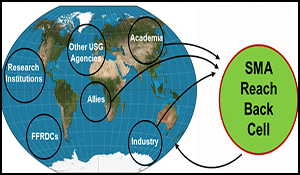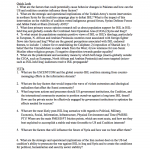Round 1 Questions Compilation
January 2017 No Comments

Compilation of Round 1 Questions.
Author | Editor: Rhem, S. (SRC & SMA Team).
Round 1 Questions
Quick Look
- What are the factors that could potentially cause behavior changes in Pakistan and how can the US and coalition countries influence those factors?
- What are the strategic and operational implications of the Turkish Army’s recent intervention in northern Syria for the coalition campaign plan to defeat ISIL? What is the impact of this intervention on the viability of coalition vetted indigenous ground forces, Syrian Defense Forces and Jabhat Fatah al-Sham (formerly ANF)?
- What does primary source opinion research tell us about population support for ISIL in ISIL- held Iraq and globally outside the Combined Joint Operation Area (CJOA) (Syria and Iraq)?
- To what extent do populations maintain positive views of ISIL or ISIL’s ideology, particularly in European, N. African and Arabian Peninsula countries most associated with foreign fighter flows into Syria and Iraq? What are the general perceptions associated with ISIL endorsed themes, to include: 1) desire for re-establishing the Caliphate; 2) imposition of Shariah law; 3) belief that the Ummah/Islam is under attack from the West; 4) low tolerance for non-Sunni Muslim ethno-religious groups; 5) negative disposition towards gender equality?
- What are the predominant and secondary means by which both large (macro-globally outside the CJOA, such as European, North African and Arabian Peninsula) and more targeted (micro- such as ISIL-held Iraq) audiences receive ISIL propaganda?
ViTTa
- What are the USCENTCOM and the global counter-ISIL coalition missing from counter-messaging efforts in the information domain?
- What are the key factors that would impact the wave of violent extremism and ideological radicalism that affect the Sunni community?
- What long-term actions and processes should US government institutions, the Coalition, and the international community examine to position ourselves against a long term ISIL threat? How can the private sector be effectively engaged by government institutions to optimize the effects needed for success?
- What are the most likely post-ISIL Iraq scenarios with regards to Political, Military, Economic, Social, Information, Infrastructure, Physical Environment and Time (PMESII- PT)? Where are the main PMESII-PT friction points, which are most acute, and how are they best exploited to accomplish a stable end-state favorable to US and Coalition interests?
- What are the factors that will influence the future of Syria and how can we best affect them?
- What are the strategic and operational implications of the Iran nuclear deal on the US-led coalition’s ability to prosecute the war against ISIL in Iraq and Syria and to create the conditions for political, humanitarian and security sector stability?
- What are the strategic objectives and motivations of indigenous state and non-state partners in the counter-ISIL fight?
Literature Review
- What opportunities are there for USCENTCOM to shape a post-ISIL Iraq and regional security environment promoting greater stability?
- What will be Iran’s strategic calculus regarding Iraq and the region post-ISIL? How will JCPOA impact the calculus? What opportunities exist for the US/Coalition to shape the environment favorable to our interests?
- What action and policies can regional and coalition nations employ to reduce recruitment of ISIL inspired fighters?
- What is the strategic framework for undermining ISIL’s “Virtual Caliphate”?
- Given the generational nature of the threats we face, what changes in organization, legislation, authorities, resources, infrastructure, education, and other areas should the USG make to become as agile, resilient, survivable, sustainable, technologically and intellectually dominant as required to protect our constitutional system and prevail in any conflict from the present until 2050?
Simulation
- What are the correlations between the US/coalition operational and tactical actions in theater effecting terrorist activity throughout the world (i.e., external events). For example, does the loss of ISIL controlled territory or kill/capture of an ISIL high value target lead to an increase/decrease in terrorist attacks in other areas of the world? Can location, intensity, duration or timing of attacks be predicted from a model?
- In light of their divergent goals and interests, what are the necessary factors that would permit the US-led coalition, regional stakeholders (including Israel, Russia and Iran) or jihadist groups to achieve their aims in Iraq and Syria? Where do disparate groups’ interests align and where do they diverge? What can the US-led coalition do to deny adversaries the ability to achieve their goals?
- What must the coalition do in the information environment to achieve its objectives in Iraq and Syria and how can it deny adversaries the ability to achieve theirs?
Round 2 Questions
-
Follow-up questions to the responses to Quick Look Question 3 concerning opinion research data on popular support for ISIL (9 Sept 16 Memo):
- Have sentiments changed since the December 2014 polling? Have recent IO efforts in Mosul influenced these sentiments? What other means can we use to influence?
- In countries where polling shows favorable opinions of ISIL (Syria, Nigeria, Tunisia, Senegal and Malaysia), what does this tell us? What do these countries have in common? What is our best approach to influence/inform?
- The response to QL5 noted that ISIL is moving to ZeroNet platform for peer-to-peer messaging, which is extremely robust to distributed denial-of-service (DDOS) attack/other counter measures. What effect could this have on Intel efforts?
- The wide-spread, public access to smartphones has been a game-changer for the distribution and production of propaganda. Is there more data available about the types of apps (e.g., WhatsApp, Facebook, Telegram, Viber) used on smartphones to distribute propaganda, and the methods through which this is accomplished?
- What are potential unanticipated complications or reactions (or “black swans”) with respect to defeating ISIL in al-Raqqah?
- What are near and long term Turkish interests and intentions in Syria and Iraq? What are Turkish interests and intentions with respect to al-Bab?
- What significance will small military groups, particularly in Northern Syria, have in a post-ISIL Levant? How should CENTCOM best shape or influence these groups?
- How does the U.S./Coalition view Shia extremism? Different from Sunni extremism? How do Sunni communities, Shia communities, MENA countries, and media perceive the U.S./Coalition position on combatting extremists?
- What internal factors would influence Iran’s decision to interfere with the free flow of commerce in the Strait of Hormuz or the Bab el Mandeb?
- What improvements can be made towards the development of a comprehensive process to rapidly Build Partner Capacity (BPC) in select contingency scenarios (acquisition, fielding, distribution, maintenance and accountability of materiel)?
- What major economic, political and security (military) activities does KSA and Iran currently conduct in Bahrain, Lebanon, Iraq, Syria, and Yemen to gain influence? What are KSA and Iran’s ultimate goals behind these activities? What motivates KSA and Iran towards these goals? What future activities might KSA and Iran conduct in Bahrain, Lebanon, Iraq, Syria, and Yemen?
- How does the Israeli Palestinian Conflict influence, effect, and relate to current conflicts in the region?
- What are the key factors or elements within the Government of Iraq that influence overall stability in Syria and Iraq? What are the tipping points for each?
Follow-Up questions to the responses to Quick Look Question 5 on the predominant means by which ISIL promulgates its message (9 Sept 16 Memo):
New Questions:
Question (R2 Special): What are the indicators of changes in Russian strategic interests in Syria?
Third Round of Questions from CENTCOM
-
Quick Look Questions on Iraq (Due mid-Dec 2016)
- Are Government of Iraq initiatives for political reconciliation between the sectarian divide moving in step with military progress against Da’esh, and what conditions need to be met in order to accommodate the needs of the Sunni population?
- How does Da’esh’s transition to insurgency manifest itself, and what actions should the Coalition take to minimize their ability to maintain either military effectiveness or popular support?
- What are the aims and objectives of the Shia Militia Groups following the effective military defeat of Da’esh?
- What are the critical elements of a continued Coalition presence , following the effective military defeat of Da’esh that Iran may view as beneficial?
- Following the clearance of Da’esh from both Mosul and Raqqah , and beyond that any remaining substantive elements in the Euphrates River Valley, what governing structure is most likely to be effective, and acceptable to the predominant tribes?
- How will the population in northwest Syria react to future Salafist political institutions?
- How does Da’esh ‘s transition to insurgency manifest itself in Syria; which other jihadist groups might offer the potential for merger and which areas of ungoverned space are most likely to offer conditions conducive for Da’esh to maintain some form of organizational structure and military effectiveness?
Quick Look Questions on Syria (Due end of January 2017)

Comments